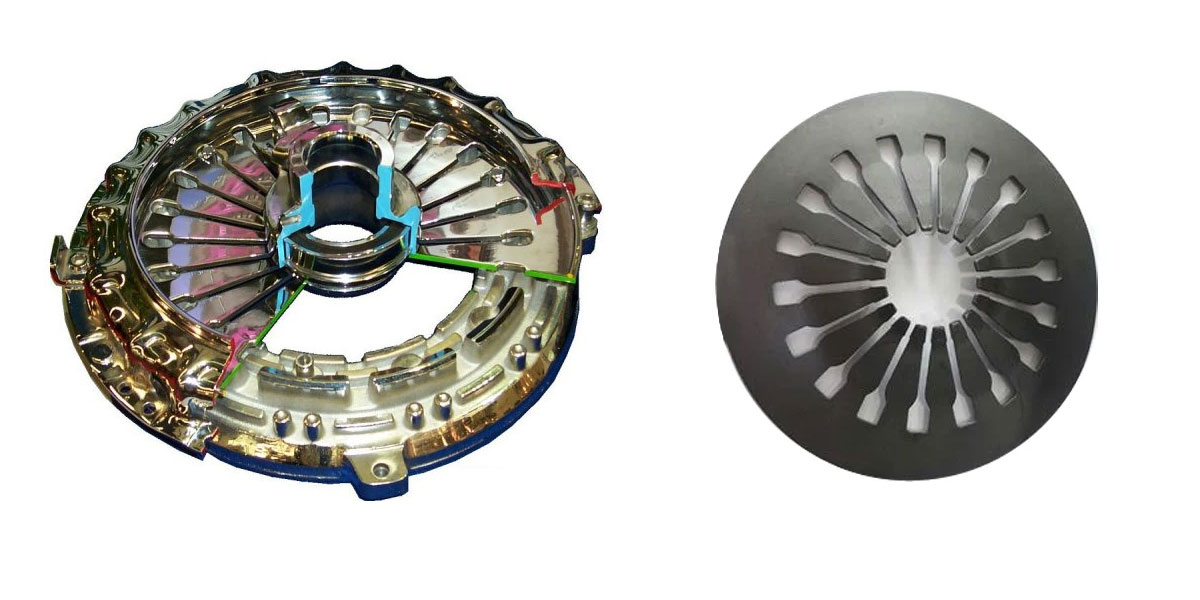In the world of manual transmissions, the diaphragm spring has quietly revolutionized clutch performance and reliability. As the primary component within the clutch pressure plate assembly, diaphragm springs play a pivotal role in engaging and disengaging power transmission from the engine to the drivetrain. For engineers and procurement specialists alike, understanding their structure, material science, performance metrics, and failure modes is essential for selecting and sourcing the right component for both OEM and aftermarket needs.

1. How a Diaphragm Spring Works
A diaphragm spring is a coned disk of spring steel with radial fingers (or “fingers”) extending inward. When the clutch pedal is pressed, a release bearing pushes against these fingers, flattening the spring. This action releases the clamping force on the clutch disc, disengaging the engine from the transmission.
When the clutch pedal is released, the spring returns to its coned shape, pressing the pressure plate against the clutch disc, re-engaging power transmission. The spring’s geometry ensures a compact design and uniform pressure distribution.
2. Materials and Surface Treatments
(1) Common Materials
- 60Si2Mn (Silicon-Manganese Spring Steel): Good fatigue strength and elasticity.
- 50CrVA (Chromium-Vanadium Steel): High resistance to fatigue and deformation.
- SUP9: Used in high-stress environments, with good tempering characteristics.
(2) Surface Treatments
- Shot Peening: Introduces compressive stress, improving fatigue life.
- Phosphating: Adds corrosion resistance and improves lubrication retention.
- Nitriding: Enhances surface hardness and wear resistance.
These treatments are crucial for extending diaphragm spring life, particularly under high-torque or high-cycle conditions.
3. Key Design Parameters
| Parameter | Description | Typical Value |
|---|---|---|
| Clamping Load | Axial force exerted on clutch disc | 5,000–15,000 N |
| Spring Thickness | Blade thickness of diaphragm | 2.5–4.5 mm |
| Number of Fingers | Determines load distribution | 18–24 |
| Working Deflection | Angular change during actuation | 8°–15° |
| Fatigue Life | Operational cycles before preload loss | >1 million cycles |
These parameters must be carefully matched to engine torque, RPM range, and expected lifecycle to ensure optimal clutch performance.
4. Advantages Over Coil Springs
- Compact Design: Reduces clutch pack size, allowing for lighter flywheels.
- Consistent Clamping Force: Better pressure uniformity and engagement smoothness.
- Lower Actuation Force: Lighter pedal feel; ideal for hydraulic clutch systems.
- Better Manufacturability: Easier integration into automated production lines.
For procurement teams, diaphragm springs often offer a more cost-effective and scalable solution over traditional coil-based assemblies.
5. Common Failure Modes and Maintenance Indicators
(1) Failure Indicators
- Cracked or broken spring fingers
- Inconsistent pedal feel or engagement point
- Clutch slippage under load
(2) Root Causes
- Overheating from excessive clutch slip
- Material fatigue due to poor heat treatment
- Improper alignment or bearing failure
Routine inspections during clutch servicing can prevent costly transmission damage and downtime.
6. Application Scope and Emerging Trends
Diaphragm springs are standard in most passenger vehicles and commercial trucks with manual transmissions. High-performance variants are used in motorsport applications where fast engagement and high torque loads are prevalent.
As electric vehicles adopt range extenders and hybrid configurations with clutch-based engagement systems, the diaphragm spring’s relevance continues to evolve.
References
- Zhang, Y., & Chen, X. (2020). Fatigue Life Evaluation of Automotive Diaphragm Springs. SAE Technical Paper 2020-01-1204.
- Kimura, H. (2018). Materials and Surface Treatment in Spring Components. Journal of Materials Engineering, 34(3), 145-153.
- SAE International. (2022). Manual Transmission Clutch System Design Guide. SAE Handbook.
- Dorman, J. (2021). Clutch Spring Dynamics and Failure Analysis. Automotive Powertrain Review, 17(2), 80-92.
